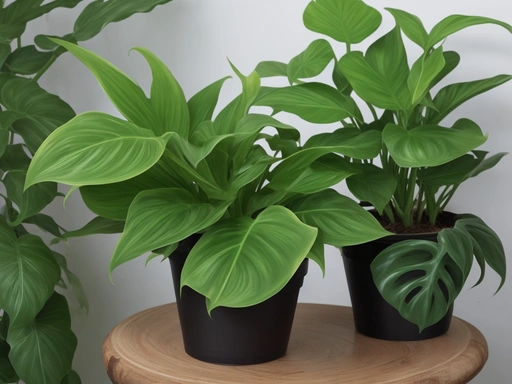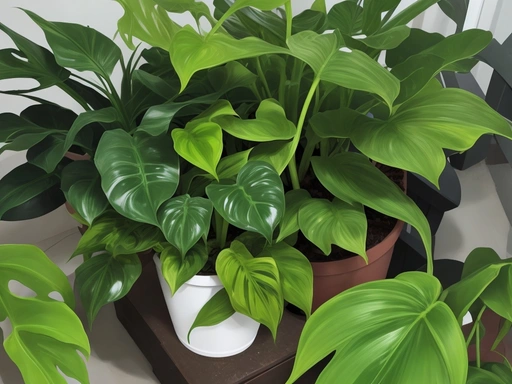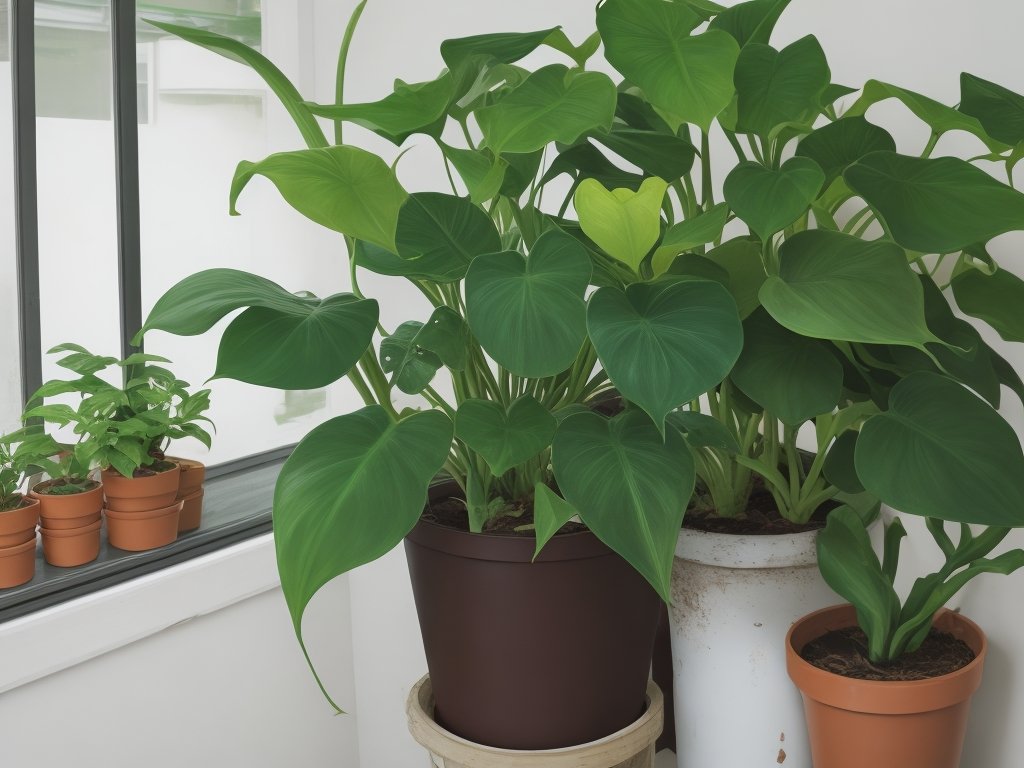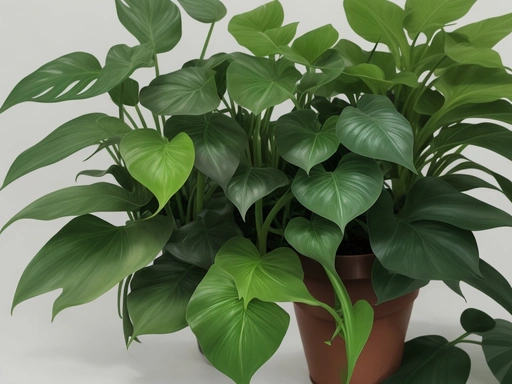Philodendron Hanging Basket Care: Tips for Thriving Plants
Key Takeaways:
- Watering: Philodendron hanging baskets should be watered thoroughly, allowing the soil to dry out slightly between waterings.
- Light: These plants thrive in bright, indirect light. Avoid direct sunlight as it can scorch the leaves.
- Fertilization: Regularly feed your Philodendron hanging basket with a balanced fertilizer to promote healthy growth.
- Pruning: Trim dead or yellowing leaves and vines to maintain the overall appearance and health of the plant.
Are you looking to add a touch of greenery to your indoor space? Philodendron hanging baskets might just be the perfect solution! These beautiful plants are not only aesthetically pleasing but also relatively easy to care for.
From choosing the right variety to setting up the ideal environment, I will guide you through all the necessary steps to ensure your Philodendron thrives in its hanging home.
Join me as we explore the essentials of Philodendron hanging basket care, including tips for pruning, fertilizing, dealing with common pests, and troubleshooting common issues. Let’s get started!
| Aspect | Requirements |
| Light | Bright, indirect light |
| Watering | Allow top inch of soil to dry before watering |
| Fertilizer | Use a balanced liquid fertilizer once a month during the growing season |
| Temperature | 65-75°F (18-24°C) during the day, slightly cooler at night |
| Humidity | Requires high humidity; mist leaves or use a humidifier |
| Pruning | Remove dead or yellowing leaves regularly; trim unruly vines as needed |
| Propagation | Can be propagated through stem cuttings or air layering |
| Pests | Watch for spider mites, mealybugs, and scale insects |
| Toxicity | Keep away from pets and children; sap can cause irritation |
Choosing the Right Philodendron for your Hanging Basket
Choosing the right Philodendron for your hanging basket depends on understanding the different varieties and considering key factors.
Understanding the Different Philodendron Varieties
There are many different philodendron varieties to choose from for your hanging basket. Some popular options include the philodendron micans, hederaceum, brasil, and scandens.
Each variety has its own unique characteristics, such as leaf shape, color, and growth habit.
Some have trailing vines, while others have more compact growth. Consider your personal preferences and the specific conditions in your home when choosing the right variety for your hanging basket.

Factors to Consider when Choosing a Philodendron for Hanging Baskets
When choosing a Philodendron for a hanging basket, there are a few factors to consider.
Firstly, think about the size and growth habit of the plant.
You want a Philodendron that will stay compact and not outgrow the hanging basket too quickly.
Secondly, consider the light requirements.
Some Philodendron varieties prefer bright indirect light, while others can tolerate lower light conditions.
Lastly, consider the water needs of the plant.
You’ll want a Philodendron that can handle the amount of watering you’re able to provide.
Setting Up the Ideal Environment for your Philodendron Hanging Basket
To set up an ideal environment for your Philodendron hanging basket, consider factors like light, temperature, humidity, potting mix, container, watering, and drainage.
Providing Adequate Light for your Philodendron
To ensure that your Philodendron thrives, it’s important to provide adequate light.
Philodendrons prefer bright, indirect light, so placing them near a window where they can receive filtered sunlight is ideal.
Avoid direct sunlight as it can burn the leaves.
If your space doesn’t receive much natural light, you can also use artificial grow lights to supplement the light requirements of your Philodendron.
Just make sure to position the lights a few feet above the plant and provide them with 10-12 hours of light per day.
Remember, finding the right balance of light is crucial for the health and growth of your Philodendron hanging basket.
Maintaining the Right Temperature and Humidity Levels
Maintaining the right temperature and humidity levels is crucial for the health of your Philodendron hanging basket. Aim for a temperature range of 65-75°F (18-24°C) during the day and 55-65°F (13-18°C) at night.
Keep the humidity levels between 40-60% by misting the leaves or using a humidifier.
Avoid placing your plant near drafts or heat sources.

Selecting the Appropriate Potting Mix and Container
To select the appropriate potting mix for your Philodendron hanging basket, look for a well-draining blend that retains moisture without becoming waterlogged.
A mix with peat moss, perlite, and compost is a good choice.
As for the container, opt for one with drainage holes to prevent water accumulation.
Choose a size that allows room for growth but doesn’t overwhelm the plant.

Watering and Drainage Considerations
To ensure the health of your Philodendron hanging basket, proper watering and drainage are crucial considerations. Here’s what you need to keep in mind:
- Watering frequency: Water your Philodendron when the top inch of soil feels dry to the touch. Avoid overwatering, as this can lead to root rot.
- Watering method: Use a watering can or a gentle stream of water to evenly moisten the soil. Avoid getting water on the leaves, as this can encourage disease.
- Drainage: Make sure your hanging basket has drainage holes to allow excess water to escape. This prevents water from pooling and causing root damage.
- Drainage layer: Place a layer of rocks or pebbles at the bottom of the basket before adding the potting mix. This helps improve drainage and prevents waterlogging.
- Watering consistency: Be consistent with your watering schedule, as regular fluctuations can stress the plant. Aim for a steady and balanced watering routine.
Remember, finding the right balance between watering and drainage is key to maintaining a healthy Philodendron hanging basket. Keep an eye on the soil moisture and adjust your watering accordingly.

Essential Care Tips for Philodendron Hanging Baskets
Taking care of your Philodendron hanging baskets is easy when you follow these essential care tips
Pruning and Propagation Techniques
To prune your Philodendron hanging basket, start by removing dead or yellowing leaves.
You can also trim back leggy stems to encourage bushier growth.
For propagation, take stem cuttings with at least two nodes and place them in water or a moist potting mix.
Keep them in a warm, bright spot and mist regularly until roots develop.
Fertilizing your Philodendron
Fertilizing your Philodendron is essential for its growth and health. Use a balanced, water-soluble fertilizer and dilute it according to the instructions.
Apply the fertilizer every 4-6 weeks during the growing season, spring to fall.
Avoid over-fertilizing, as it can cause nutrient burn and damage the plant. Regular fertilization will help your Philodendron thrive and stay vibrant.
Dealing with Common Pests and Diseases
Dealing with common pests and diseases in your philodendron hanging basket is essential for keeping your plant healthy. Here are some tips to help you tackle these issues:
- Identify the problem: Take a close look at your plant and identify any signs of pests or diseases. Look for insects, webs, spots on leaves, or wilting.
- Treatment for pests: If you spot pests like aphids, mealybugs, or spider mites, try using an insecticidal soap or neem oil spray. Apply according to the product instructions and repeat as necessary.
- Preventing pests: Keep your plant clean by removing dead leaves and debris regularly. Quarantine new plants before introducing them to your hanging basket to prevent pest infestations.
- Fungal diseases: If you notice fungal diseases like leaf spots or powdery mildew, remove affected leaves and improve air circulation around the plant. Avoid overhead watering to prevent moist conditions that promote disease.
- Root rot prevention: Overwatering can lead to root rot. Ensure your hanging basket has proper drainage and avoid letting the soil become waterlogged. Let the top inch of soil dry out between waterings.
Remember, early detection and proper treatment are key to keeping your philodendron hanging basket thriving.
Regular Cleaning and Dusting
Regular cleaning and dusting is important for maintaining the health and appearance of your Philodendron hanging basket.
Dust can accumulate on the leaves, blocking sunlight and hindering photosynthesis.
Use a soft cloth or brush to gently wipe the leaves and remove any dust buildup.
Additionally, you should periodically clean the leaves by misting them with water or using a damp cloth to keep them clean and free from pests.
This will ensure that your Philodendron remains healthy and vibrant.
Troubleshooting Common Issues with Philodendron Hanging Baskets
Let’s troubleshoot common issues with Philodendron hanging baskets.
Yellowing Leaves and Leaf Drop
Yellowing leaves and leaf drop in philodendron hanging baskets can be caused by several factors.
Overwatering is a common culprit, so ensure the soil is well-drained and avoid waterlogged conditions.
Inadequate light can also lead to yellowing leaves, so make sure your plant receives enough indirect sunlight.
Lastly, nutrient deficiencies or pests could be causing the issue, so regularly fertilize your plant and keep an eye out for any pests.
Overwatering and Root Rot
Overwatering is a common issue that can lead to root rot in philodendron hanging baskets. It’s important to avoid watering too frequently or allowing the roots to sit in soggy soil.
Ensure that the soil has proper drainage and allow it to dry out slightly between waterings.
Regularly check the moisture level by sticking your finger about an inch into the soil. If it feels dry, it’s time to water.
Browning Leaf Tips and Edges
Browning leaf tips and edges can be caused by several factors. One common culprit is underwatering, so make sure you’re providing enough water.
Chemical buildup in the soil can also lead to browning, so flush the soil occasionally.
Another possibility is low humidity; misting or using a humidifier can help. Finally, check for pests like spider mites, as they can cause browning too.
Drooping and Limp Leaves
Drooping and limp leaves are often a sign of overwatering.
To remedy this, check the moisture level of the soil and adjust your watering schedule accordingly.
Ensure that your philodendron’s pot has proper drainage to prevent water from pooling.
Additionally, make sure your plant is receiving adequate light and consider adjusting the temperature and humidity levels if necessary.
Frequently Asked Questions about Philodendron Hanging Basket Care
How often should I water my Philodendron hanging basket?
Water your Philodendron hanging basket when the top inch of the soil feels dry to the touch. Stick your finger into the soil to check the moisture level.
Depending on the environmental conditions, this could be around once a week or every 10-14 days.
Adjust the frequency based on how quickly the soil dries out. Avoid overwatering, as it can lead to root rot.
Can Philodendron thrive in low light conditions?
Philodendrons can thrive in low light conditionstions. They are known for being adaptable and can survive in lower light levels compared to other houseplants.
However, it’s important to note that while they can tolerate low light, they may not grow as vigorously or produce as many leaves.
If placed in very low light, their growth may become stunted and the foliage may lose its vibrant color. It’s best to provide them with bright, indirect light for optimal growth.
If you have a darker corner in your home, there are some Philodendron varieties that are better suited for low light conditions, such as the Heartleaf Philodendron (Philodendron hederaceum) or the Velvet Leaf Philodendron (Philodendron micans).
So, if you have a spot with lower light levels, you can still enjoy the beauty of a Philodendron, just make sure to choose a variety that is well-suited for low light conditions.
How can I prevent my Philodendron from getting too leggy?
To prevent your Philodendron from getting too leggy, make sure it receives enough light.
Place it in a bright location, but avoid direct sunlight.
Rotate the plant regularly to promote even growth.
Also, avoid over-watering and provide well-draining soil to maintain the plant’s health.
Regularly prune your Philodendron to encourage bushier growth and pinch off any leggy stems.
What should I do if my Philodendron is attracting pests?
If your Philodendron is attracting pests, the first thing you need to do is to identify the type of pest. Once you know what you’re dealing with, you can choose the most appropriate treatment method.
Some common options include using natural insecticidal soaps, neem oil, or introducing beneficial insects.
Additionally, make sure to keep your plant clean and monitor it regularly for any signs of pests.
Final Verdict
Caring for a Philodendron hanging basket requires careful consideration of the right variety, environment, and maintenance techniques.
By understanding the different Philodendron varieties and selecting the appropriate one for your hanging basket, providing adequate light, temperature, and humidity, choosing the right potting mix, and properly watering and draining, you can create an ideal environment for your plant to thrive.
Additionally, regular pruning, fertilizing, and cleaning, as well as addressing common issues and implementing preventive measures, will ensure your Philodendron hanging basket remains healthy and beautiful.
With the tips and techniques mentioned in this article, you can confidently care for your Philodendron hanging basket and enjoy the lush, trailing foliage it provides.







